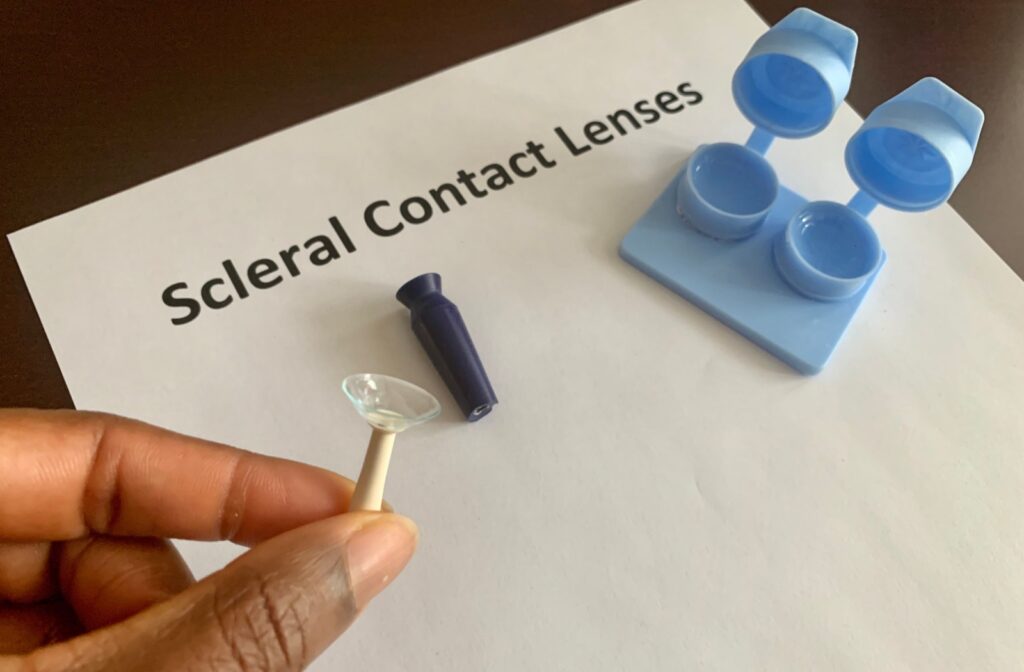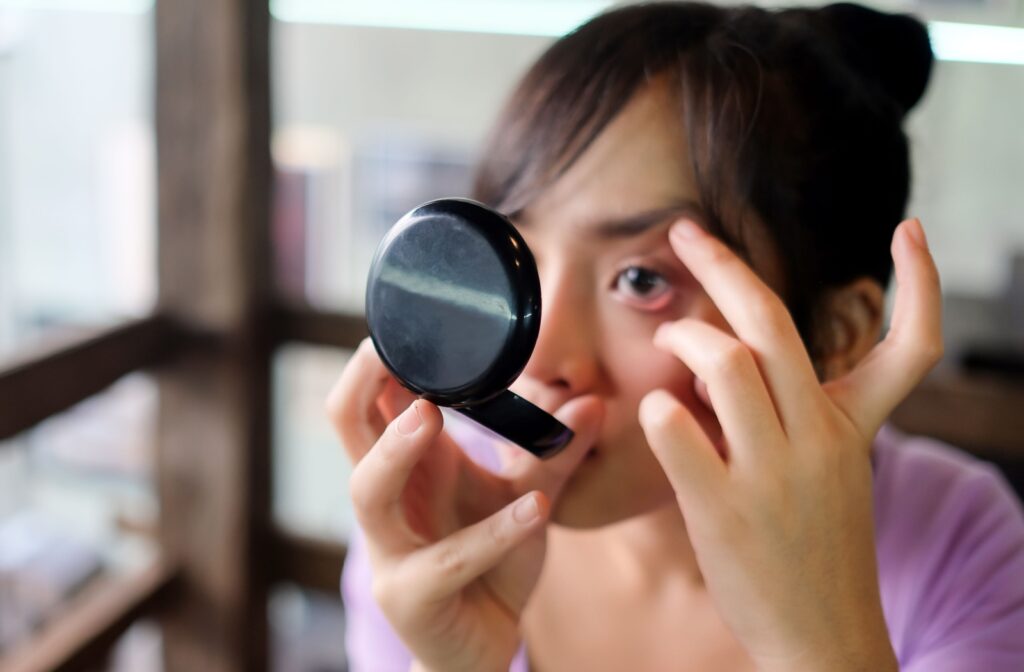Scleral lenses are slightly different from regular contact lenses. Used to treat certain eye conditions and high degrees of refractive error, these lenses cover a wider area of your eye. Similar to regular contact lenses, inserting scleral lenses requires attention to hygiene, and you may need some extra time to get used to them.
To insert scleral lenses, make sure your hands are clean and fill the lens with a saline solution or another fluid recommended by your optometrist. Then, you can either use your fingers or a contact lens applicator to insert the lens. As always, if you have any questions or concerns, don’t hesitate to visit your optometrist.
Introduction to Scleral Lenses
Similar to regular contact lenses, scleral lenses rest directly on the eye. The difference is that scleral lenses cover a wider area of the eye. Specifically, they rest on part of the sclera (the white part of your eye) and curve over the cornea (the dome-shaped layer on top).
This leaves space between the scleral lens and the cornea to hold saline or another fluid. The lens is also held under your eyelids at the top and bottom, so it’s less likely to slip off than a regular contact lens. Some people also find them more comfortable to wear due to their placement.
Who Are Scleral Lenses For?
There are many reasons why someone may be prescribed scleral lenses. This type of lens can be used to treat:
- Diseases of the cornea, such as keratoconus
- Severe dry eye disease
- Severe refractive errors, such as high myopia
- Conditions that require holding a liquid medication on the surface of your eye
- Other conditions that affect the eye’s surface, eyelid, and area around the eye
In some cases, scleral lenses can even help people avoid or delay surgery.

How to Insert Scleral Lenses
Learning how to insert contact lenses can be intimidating. If you have any questions or concerns, discuss them with your optometrist. The following are general steps, and your optometrist should guide you on the specifics.
- Step #1: Wash your hands. Make sure you only handle your contact lenses with thoroughly washed and dried hands. Use soap.
- Step #2: Fill the lens. Hold your contact lens like a bowl and fill it with saline solution or another liquid recommended by your optometrist. Fill the lens until it overflows; this allows enough liquid to fill the pocket between the lens and your eye.
- Step #3: Hold the lens. You can hold your lens with the “tri-pod” method by putting it on the tips of your thumb, middle finger, and index finger. You can also use an applicator tool.
- Step #4: Look down. Position yourself so that your face is aligned and parallel to the floor. This helps keep the liquid from spilling out of the lens.
- Step #5: Open up your eyelids. Pull your upper eyelid upwards and your lower eyelid downwards.
- Step #6: Insert the lens: Place the lens on the surface of your eye. Once you feel it make contact, release your upper eyelid, making sure it covers the upper edge of the lens. Then do the same with your lower eyelid. You can also try keeping your fingers on your eyelids until you’re certain the lens is secure beneath them.
If there’s an air bubble between the lens and your eye, remove your lens and try again.
Getting Comfortable With Scleral Lenses
It’s normal for scleral lenses to take a little extra time to get used to. You may need to wear your lenses for a shorter period of time when you first start.
If your lenses feel out of place, are difficult to remove, or if you feel that your vision with them has changed, talk to your optometrist. You should also refrain from wearing your contacts and should visit your optometrist as soon as possible if you notice any pain or discomfort.
Care Tips for Scleral Lenses
Understanding how to clean and care for your contact lenses is essential. Scleral lenses, in particular, can trap debris in the space between the cornea and the lens. Therefore, many wearers need to clean their lenses at some point during the day. Improper care or hygiene can lead to infections and other problems.
Here are some basic guidelines to follow:
- Practice good hand hygiene: Always wash your hands with soap and water and dry them before handling, inserting, or removing your contact lenses.
- Don’t use alternative solutions: Never use tap water, saliva, or any solution other than the one your optometrist recommends to clean them.
- Pay attention to expiration dates: Don’t use expired solutions and pay attention to the discard date, which is the date a product should be disposed of after opening. Read the package instructions and ask your optometrist if you need any clarification. In general, single-use vials of liquid should be discarded within 24 hours.
- Consult with your optometrist before using eye drops: Some types of eye drops can harm the lens or your eye, so ask your optometrist what products are safe.
Scleral Lenses: Next Steps
If you have a condition like dry eye or a high prescription, scleral lenses may be an option. And while contact lenses can take time to get used to, they offer freedom from glasses and convenience for many. Curious about contact lenses? The first step is scheduling a contact lens fitting and exam with an optometrist. We’ll assess your candidacy for contact lenses, measure your eyes for a proper fit, and teach you how to wear and care for your lenses. To get started, book an appointment with River City Vision Center in Jacksonville or Orange Park today.





